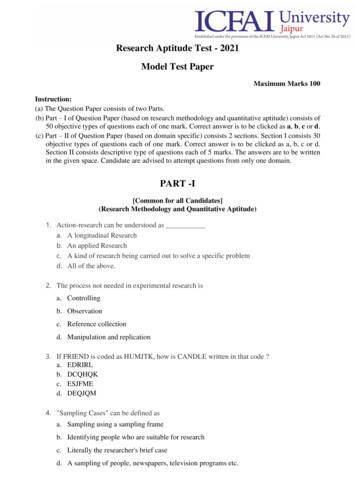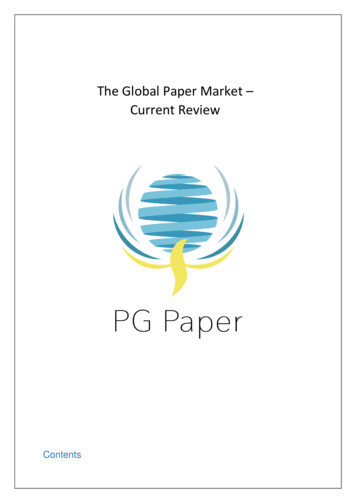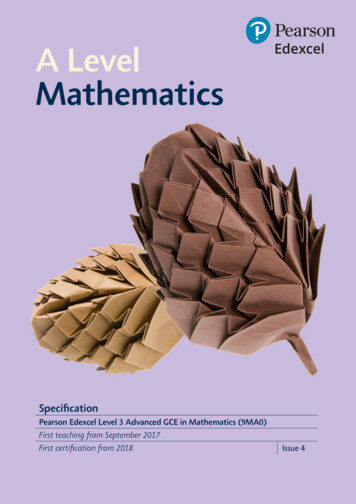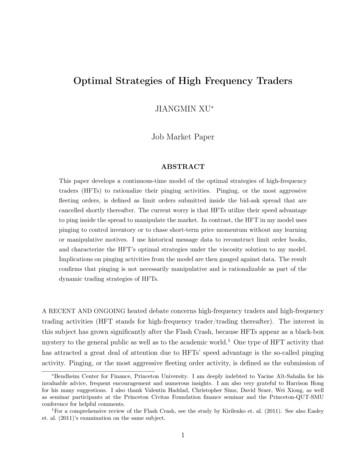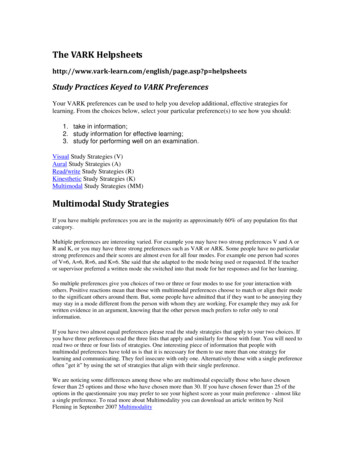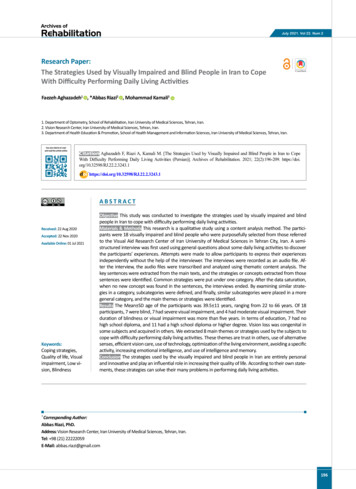
Transcription
July 2021. Vol 22. Num 2Research Paper:The Strategies Used by Visually Impaired and Blind People in Iran to CopeWith Difficulty Performing Daily Living ActivitiesFaezeh Aghazadeh1 , *Abbas Riazi2 , Mohammad Kamali31. Department of Optometry, School of Rehabilitation, Iran University of Medical Sciences, Tehran, Iran.2. Vision Research Center, Iran University of Medical Sciences, Tehran, Iran.3. Department of Health Education & Promotion, School of Health Management and Information Sciences, Iran University of Medical Sciences, Tehran, Iran.Use your device to scanand read the article onlineCitation Aghazadeh F, Riazi A, Kamali M. [The Strategies Used by Visually Impaired and Blind People in Iran to CopeWith Difficulty Performing Daily Living Activities (Persian)]. Archives of Rehabilitation. 2021; 22(2):196-209. i.org/10.32598/RJ.22.2.3243.1ABSTRACTReceived: 22 Aug 2020Accepted: 22 Nov 2020Available Online: 01 Jul 2021Keywords:Coping strategies,Quality of life, Visualimpairment, Low vision, BlindnessObjective This study was conducted to investigate the strategies used by visually impaired and blindpeople in Iran to cope with difficulty performing daily living activities.Materials & Methods This research is a qualitative study using a content analysis method. The participants were 18 visually impaired and blind people who were purposefully selected from those referredto the Visual Aid Research Center of Iran University of Medical Sciences in Tehran City, Iran. A semistructured interview was first used using general questions about some daily living activities to discoverthe participants’ experiences. Attempts were made to allow participants to express their experiencesindependently without the help of the interviewer. The interviews were recorded as an audio file. After the interview, the audio files were transcribed and analyzed using thematic content analysis. Thekey sentences were extracted from the main texts, and the strategies or concepts extracted from thosesentences were identified. Common strategies were put under one category. After the data saturation,when no new concept was found in the sentences, the interviews ended. By examining similar strategies in a category, subcategories were defined, and finally, similar subcategories were placed in a moregeneral category, and the main themes or strategies were identified.Results The Mean SD age of the participants was 39.5 11 years, ranging from 22 to 66 years. Of 18participants, 7 were blind, 7 had severe visual impairment, and 4 had moderate visual impairment. Theirduration of blindness or visual impairment was more than five years. In terms of education, 7 had nohigh school diploma, and 11 had a high school diploma or higher degree. Vision loss was congenital insome subjects and acquired in others. We extracted 8 main themes or strategies used by the subjects tocope with difficulty performing daily living activities. These themes are trust in others, use of alternativesenses, efficient vision care, use of technology, optimization of the living environment, avoiding a specificactivity, increasing emotional intelligence, and use of intelligence and memory.Conclusion The strategies used by the visually impaired and blind people in Iran are entirely personaland innovative and play an influential role in increasing their quality of life. According to their own statements, these strategies can solve their many problems in performing daily living activities.Corresponding Author:Abbas Riazi, PhD.Address: Vision Research Center, Iran University of Medical Sciences, Tehran, Iran.Tel: 98 (21) 22222059E-Mail: abbas.riazi@gmail.com*196
July 2021. Vol 22. Num 2LExtended AbstractMaterials and MethodsIntroductionThis research is a qualitative study using content analysis.The samples were purposefully selected from people withvisual impairments living in Tehran City referred to the Visual Aid Research Center of the Faculty of Rehabilitation,Iran University of Medical Sciences. First, the participant’sability to take part in the research was assessed by performing a perception test in the form of asking a series of simple questions. The purpose of the study was explained tothem or their families or companions, and their consent wasobtained to record their voices during the interview. Afterpreparing a separate record file for each of them, they wereassured that their information would remain confidential.A semi-structured interview was conducted using generalquestions about some daily living activities to discover theexperiences of visually impaired and blind people. Attemptswere made to allow participants to express their experiencesindependently without the help of the interviewer. The initial optometric examinations included surveying the historyof the disease and treatments performed so far, measuringvision with and without optical correction at near and fardistances, assessing the refractive errors, and recording thehistory of visual aids use. The visual chart used in this studyat near and far distances was the standard logarithmic visionchart. Refractive errors were measured by retinoscope. Afterthe initial examinations, the participants were selected andinterviewed. The inclusion criteria were having moderateto severe visual impairment or blindness according to theWorld Health Organization’s criteria for the classification oflow vision, being over 20 years old with at least five yearsof visual impairment, being able and willing to participate inthe research, and lacking perceptual problems.ow vision is a visual impairment. In thiscondition, a person’s vision does not improve with any medication, surgery, andglasses, and contact lenses. Due to population growth in different parts of the world,visual impairment and blindness are increasing in the world[1]. The causes of low vision and blindness are differentand can occur in any race, ethnicity, nationality, and familyhistory [2]. According to many studies, vision loss declinesthe quality of life [3]. Vision is a crucial factor in mentalhealth. A person with visual impairment has difficulty doing their daily chores and sometimes becomes dependenton others for performing simple tasks. This dependencecan lower the self-esteem of a visually impaired person andcause dissatisfaction with life and depression [4]. Many solutions have been suggested to improve the quality of lifeof these people. One of these strategies is applying practicalstrategies that are invented and used by blind or visuallyimpaired people to do their daily living activities [5]. Also,therapists and rehabilitation specialists should pay attentionand be aware of these strategies and encourage visually impaired people to use them [6].Therapists who assess visual acuity should consider theirpatients’ coping mechanisms and refer them for positivecounseling and training in appropriate ways [3]. One studyexamined the psychological impact of vision impairmentand coping strategies in retired working women and howto cope with their low vision. Women could apply different coping strategies in their daily work, such as having apositive attitude, re-learning skills, and using visual aids[7]. Avoidance, problem-solving, and active search for social support can be other strategies [5]. One study examined coping with vision-related goal interference in midlife.The researchers found that middle-aged adults with visionimpairment use the following coping strategies: internalresource use, new approach use, technology use, help use,and psychological self-regulation [8]. Hope, coping, andfunctional ability are other strategies reported in anotherstudy [9]. Products and technology, physical environment,support and relationships, attitudes, and services and policies were environmental factors affecting the performanceof blind people in daily living activities. This study aims toinvestigate the individual applied coping strategies amongvisually impaired and blind people in Iran.197The interviews were first recorded. Then, the audio fileswere transcribed and analyzed based on the thematic content analysis. The key sentences were extracted from themain texts, and the strategies or concepts extracted fromthose sentences were identified. Common strategies wereput in one category. After the data saturation, that is, whenno new concept was found in the sentences, the interviewswere ended. By examining similar strategies in a category,subcategories were defined, and finally, similar subcategories were placed in more general categories, and the mainthemes or strategies were identified.ResultsThe participants were 18 blind or visually impaired adults(9 females and 9 males) with an average age of 39.5 years.Seven were blind, 7 had severe visual impairment, and 4had moderate visual impairment with an impairment duration of more than 5 years. In terms of education, 7 had noAghazadeh F, et al. Coping Strategies in Visually Impaired People. RJ. 2021; 22(2):196-209.
July 2021. Vol 22. Num 2high school diploma, and 11 had a high school diploma orhigher degree. Vision loss was congenital in some participants and acquired in others. Congenital glaucoma, premature retinopathy, optic nerve atrophy, trauma, night blindness, trachoma, and diabetic retinopathy were the causes ofvisual impairment of the participants.A total of 676 key sentences were extracted from the interviews. Of them, 212 concepts or applied strategies wereobtained. By categorizing common strategies, 35 sub-strategies and finally, 8 main strategies or themes were obtained,which are presented as follows:Trusting others: All participants were reported that theytrust others in performing their daily living activities.“When using an ATM, I tell someone to enter the passwordand see how much money I’ve received”.Use of alternate senses: All participants used other senses to replace the sense of vision. “At the time of study atuniversity, I gave the pamphlets to someone to read, and Irecorded his voice” (sense of hearing). “I touch the excesshair on my face with my finger, then I detect its place andremove it with a tweezer. I use my hands a lot” (sense oftouch); “If the food smells, I’ll know what the food is, likecelery. But if it does not smell, I’ll not be able to recognizeit” (sense of smell). “I know from the taste that it is, forexample, turmeric or pepper! If there is something I can’trecognize, I’ll taste a little of it” (sense of taste). “It’s a littledifficult for us, for example, since the bathroom floor isslippery, we always walk or sit in the bathroom carefullyso that we do not slip, because we can’t see the front of us”(balance). “While making a cutlet, I slide a spoon under themeat. When it makes a hissing sound, I know it’s roasted.Then, I turn it onto its other side” (proprioception).Use of technology: Most participants used science-basedtools and techniques. “I mostly use white canes outdoors.It’s not applicable indoors” (advanced equipment). “If Iwant to go somewhere by taxi that can be ordered online, Ispecify the destination early on my phone, or I ask others tocall” (modern lifestyle).Optimization of living environment: Many participantsbecame more adaptable to their environment by optimizing their surroundings. “To the relatives who sometimeswash the dishes in our house, I tell them to put everythingin its place and do not change their places” (no displacement). “Well, the toothbrushes we once bought were almostidentical such that I couldn’t differentiate them. So, I put amoney rubber band around my toothbrush” (marking). “Inthe bathroom, I have a closet like a plastic cupboard thatis personal drilled into the wall. My shampoo, towel, andother stuff are there. It’s just for me, and no one is allowedto touch them” (Separation and classification).Avoiding a specific activity: “I don’t walk on the yellowline because my foot hurts”. “I like swimming, but I don’tdo it; I’m scared to get lost in the water”. “I don’t like whitecane, and it makes me feel bad” (Lack of motivation andhaving unpleasant experiences).Increasing emotional intelligence: “Since the age of 9, Iaccepted that I had an illness that might not have a cure.I mean, it’s OK for me. This thought helped me to copewith it and live, to go to university and get a Master’s degree” (Accepting disability and positive thinking). “WhenI brush my teeth, when I comb my hair, when I’m goingto get dressed, I look at myself in the mirror spuriously. Imay not see, but it is really important for sighted people tolook in the mirror. If I don’t, it makes me feel bad; I do itbecause of them, and because I want to be like them” (beinglike normal people). “Perhaps the biggest change I made inmyself was my behavior. I admitted to myself that when Iam in a painful situation. I should laugh and rely on myselfand not grieve; I have to be able to do my own works” (selfconfidence and self-esteem).Use of intelligence and memory: “If I want to go to an address, I have to go a few more times to learn” (repetition).“Playing music is much harder for a blind person than for asighted person because the sighted person looks at the noteand plays the instrument. The blind should memorize thenote, sentence by sentence, and then play the instrument”(memorizing). “To climb up the stairs, I walk up mostlyon the left, which has a fence, because at the right sidemay be a flower pot”. (a logical connection with affairs).“When I go shopping for clothes, someone says it’s paleblue; I imagine what it’ll be like, then I buy it if I liked it.When I come home, I try to match it with my pants’ color;I say, for example, this Manto (a coat wearing by Iranianwomen) matches with these pants. I then put a blue scarf onit” (Imagination).Efficient vision use: A small number of participants continued to use their vision despite severe visual impairment.“I pour the tea into a colorless glass. It’s hard to see in a porcelain cup. I hold it in front of the light to find out if it ispale or not. I have to see the other side of the tea from oneside. Based on my experience, I know how it should be tobe good”.Aghazadeh F, et al. Coping Strategies in Visually Impaired People. RJ. 2021; 22(2):196-209.198
July 2021. Vol 22. Num 2Discussion and ConclusionVisually impaired people cannot do things that ordinarypeople can easily do using their vision [11]. People withvisual impairments lose their ability to do certain activities,partially or completely [12]. One of the strategies used bythe participants in this study was to trust others in performing activities. The type of trust depends on factors such asvisual impairment, personal mood, family conditions, society, and the type of activity [13]. Blind people use othersenses to compensate for their vision loss. This ability isdue to the reorganization of the vision-related areas of thebrain to process non-visual information such as sound andtactile stimuli [10]. Another strategy was the use of technology. The blind and visually impaired people use muchtechnology-based equipment for entertainment, education,business, communication, and so on [14]. An essential toolfor mobility and orientation used by these people is thewhite cane [15]. Advances in technology can help blindpeople be more mobile in the environment. A system called“smart vision” has been proposed for blind people, whichallows them to move around in unfamiliar environmentsusing GPS [16]. Moreover, a shoe has been designed thatcan be used to detect obstacles around a blind person whilewalking. The mechanism of informing is vibration in theankle area [17]. Nevertheless, Iranian blind and visuallyimpaired people use old canes.Some participants in this study optimized their living environment to adapt to vision problems. Marking was alsoreported to be used to identify people and things, to findtheir way around, or even to find the clothes they want. Another strategy was using emotional intelligence. Emotionalintelligence can use four skills: self-awareness, self-management, social awareness, and relationship management.The first two skills are related to how the person can understand and control their emotions. The other two skills arerelated to the person’s relationship with others by which s/he can understand the emotions of others and manage themin relation to herself/himself [18]. One of the factors thatincreased emotional intelligence in several participants inthis study was communication with other visually impairedand blind people. In addition to increasing self-confidence,this communication informed the person about new strategies used by others. Mental health is one of the most important issues that seem to need more research [18]. Accordingto many psychologists, intelligence is a set of talents withwhich we recognize, remember, and apply the elementsof culture to solve everyday problems and adapt, fix, orchange the environments [18]. One participant stated thatif he climbs up the stairs on the side where there is a fence,he probably will not hit anything because most of the time,the flower pots are placed near the wall. Another partici-199pant stated that if he crosses the street with the crowd, theprobability of an accident will decrease because the drivercan see the crowd and slow down. Some participants usedimagination to recognize objects and their surroundings andto understand colors [18].An effective vision is used when a person’s daily life isaffected by vision loss [19]. The goal of effective vision enhancement is not to increase vision but to use vision moreeffectively [19]. The purpose of vision rehabilitation forthose with visual impairment is to train independent peoplewho are capable of having a job or business and being ableto enjoy their lives. It is a type of modern rehabilitation forthe visually impaired and includes assessing remained efficient vision, providing visual rehabilitation therapies, etc.[13]. Strategies used as visual rehabilitation by participantsin this study included the use of contrast, ambient light control, visual aids, and various optical or electronic magnifierssuch as a magnifying glass, color vision assistance, and other similar techniques. Among the participants, some peoplelacked any separate optical correction for nearby objectsand did not know that they had presbyopia. They had notseen a therapist (optometrist or ophthalmologist) for years.Study recommendationsIn the present study, the cause of visual impairment andblindness was not crucial in the purposeful selection of thesamples. It is suggested that in a similar study, the type ofdisease be used as a criterion for selection to examine thedifferences between visually impaired and blind people withdifferent causes of blindness in choosing a coping strategy.Moreover, since the interview questions were limited to predetermined topics and contexts, in other studies, differentcontexts can be included in the questions to examine otheraspects of the life of the visually impaired and blind people.Blind and visually impaired Iranian people use uniquecoping strategies that can effectively improve the qualityof life of these people. Factors such as the patient’s mood,family perception of the disability, society’s general culturein recognizing and communicating with the patients, decisions, and programs of medical centers and support organizations can play an essential role in using these strategiesby blind and visually impaired people. Factors such as being rejected by the family after suffering from blindness,especially the spouse or obsessive affection and extremeworries from family members, can affect the independenceof the blind or visually impaired people and prevent the useof practical coping strategies by them and thus reduce theirquality of life. Given that the present study was conductedqualitatively, and the interviews with the participants werebased on questions with predetermined contexts, the report-Aghazadeh F, et al. Coping Strategies in Visually Impaired People. RJ. 2021; 22(2):196-209.
July 2021. Vol 22. Num 2ed strategies cannot cover all aspects of the life of the visually impaired or blind people in Iran and cannot be generalized to all visually impaired or blind people. We hope theseresults be considered a solution for other visually impairedand blind people to do their daily activities and increasetheir quality of life.Ethical ConsiderationsCompliance with ethical guidelinesAll ethical principles are considered in this article. Theparticipants were informed about the purpose of the research and its implementation stages. They were also assured about the confidentiality of their information andwere free to leave the study whenever they wished, and ifdesired, the research results would be available to them.FundingThis research did not receive any grant from fundingagencies in the public, commercial, or non-profit sectors.Authors' contributionsAll authors equally contributed to preparing this article.Conflict of interestThe authors declared no conflict of interest.AcknowledgmentsThanks to the Khazaneh Center for the Visually Impairedand Blind and all the dear and visually impaired loved oneswho cooperated with us in conducting this research.Aghazadeh F, et al. Coping Strategies in Visually Impaired People. RJ. 2021; 22(2):196-209.200
تابستان . 1400 دوره . 22 شماره 2 مقاله پژوهشی : استراتژی های منحصر به فرد ابداعی توسط کم بینایان و نابینایان ایرانی در انجام فعالیت های روزمره زندگی فائزه آقازاده 1 * ، عباس ریاضی 2 ، محمد کمالی 3 .1 گروه بینایی سنجی ، دانشکده توانبخشی ، دانشگاه علوم پزشکی ایران ، تهران ، ایران . .2 مرکز تحقیقات بینایی ، دانشگاه علوم پزشکی ایران ، تهران ، ایران . .3 گروه آموزش و ارتقاء سالمت ، دانشکده مدیریت بهداشت و علوم اطالعات ، دانشگاه علوم پزشکی ایران ، تهران ، ایران . تاریخ دریافت 01 : شهریور 1399 تاریخ پذیرش 02 : آذر 1399 تاریخ انتشار 10 : تیر 1400 اهداف این مطالعه در جهت افزایش کیفیت زندگی و به منظور بررسی تجربیات افراد کم بینا و نابینا ، از راهکارها و استراتژی های مقابله ای منحصر به فرد ، برای انطباق با کم بینایی و نابینایی صورت پذیرفت . روش بررسی این پژوهش به صورت کیفی و از نوع تحلیل محتوا انجام شد . افراد شرکت کننده به صورت هدفمند ، از بین افراد مبتال به اختالالت بینایی ساکن در شهر تهران انتخاب شدند که به مرکز تحقیقات کم بینایی دانشگاه علوم پزشکی ایران ، مراجعه کرده بودند ، با هرکدام از این افراد به صورت جداگانه مصاحبه ای با کمک پرسش نامه نیمه ساختاریافته به عمل آمد . مصاحبه به صورت پرسش نامه ، شامل سؤاالت کلی نیمه ساختاریافته ، در مورد برخی زمینه های زندگی روزمره و با هدف کشف تجربیات خود افراد کم بینا و نابینا ، صورت گرفت . در طراحی سؤاالت ، سعی شد تا افراد شرکت کننده بتوانند کام ً ال مستقل و بدون دخالت نظر مصاحبه گر ، تجربیات خودشان را آزادانه بیان کنند . صحبت ها در حین مصاحبه به صورت فایل صوتی ضبط شد . پس از انجام هر مصاحبه ، فایل صوتی به متن تبدیل شد . بر اساس روش تحلیلی مضمونی از نوع تحلیل محتوا ، آنالیز انجام شد . به این صورت که پس از نوشته شدن مصاحبه ها ، کلمات و جمالت کلیدی شرکت کنندگان ، از داخل متون اصلی بیرون کشیده شد و استراتژی ها و مفاهیم استخراج شده از آن جمالت ، مشخص شد . به تدریج که بر مفاهیم اضافه می شد ، مفاهیم مشترک ، در یک دسته بندی قرارگرفت و پس از رسیدن به اشباع ، یعنی زمانی که دیگر هیچ مفهوم جدیدی در جمالت پیدا نشد ، مصاحبه ها به پایان رسید . با بررسی استراتژی ها و مفاهیم مشابه در یک گروه ، زیرمقوله ها به دست آمدند و در ستونی جداگانه دسته بندی شدند و درنهایت ، زیرمقوله های مشابه نیز در یک دسته بندی کلی تر قرار گرفتند و مضامین یا همان استراتژی های اصلی ، مشخص شدند . کلیدواژه ها : استراتژی های مقابله ای ، کیفیت زندگی ، اختالالت بینایی ، کم بینایی ، نابینایی یافته ها در مطالعه حاضر ، از هجده نفر نابینا و کم بینای متوسط تا شدید ، مطابق با معیار ورود به پژوهش ، مصاحبه به عمل آمد . از این هجده نفر ، نه نفر زن و نه نفر مرد بودند . میانگین و انحراف معیار سنی این افراد 39/5 11 سال بود که جوان ترین آن ها فردی 22 ساله و مسن ترین آن ها فردی 66 ساله بود . هفت نفر نابینا ، هفت نفر کم بینای شدید و چهار نفر کم بینای متوسط بودند . مدت زمانی که این افراد به نابینایی یا کم بینایی مبتال بودند ، بیشتر از پنج سال بود . سطح تحصیالت در این افراد نیز متفاوت بود . هفت نفر دارای مدرک تحصیلی کمتر از دیپلم و یازده نفر نیز دارای مدرک تحصیلی دیپلم و باالتر از آن بودند . همچنین سعی شد با افراد کم بينا و نابينا که عوامل نابينايي متفاوتی داشتند مصاحبه شود . کاهش بینایی ، در بعضی افراد از بدو تولد و در بعضی دیگر اکتسابی بود . از بررسی جمالت کلیدی ، هشت مضمون اصلی یا استراتژی برای انطباق با کم بینایی و نابینایی به دست آمد که عبارت اند از : اعتماد به دیگران ، حواس جایگزین ، مراقبت از بینایی ، استفاده از تکنولوژی ، بهینه سازی محیط زندگی و سازگاری با کم بینایی و نابینایی ، عدم انجام یک فعالیت مشخص ، افزایش هوش هیجانی و به کارگیری هوش و حافظه . نتیجه گیری استراتژی های ابداعی توسط کم بینایان و نابینایان ایرانی کام ً ال شخصی و ابتکاری هستند و نقش بسیار مؤثری در افزایش کیفیت زندگی آن ها دارد . بر اساس اظهارات خودشان بسیاری از مشکالت روزمره زندگی را با همین استراتژی ها بر طرف می کنند . * نویسنده مسئول : دکتر عباس ریاضی نشانی : تهران ، دانشگاه علوم پزشکی ایران ، مرکز تحقیقات بینایی . تلفن 98 (21) 22222059 : رایانامه abbas.riazi@gmail.com : 201
تابستان . 1400 دوره . 22 شماره 2 مقدمه کم بينايي ،1 به معني اختالل بينايي است . اين شرايط به گونه اي است که ديد فرد با هيچ گونه دارو ، جراحي و عينک و لنز تماسي بهبود نمي يابد . به دليل رشد جمعيت در مناطق مختلف دنيا ، کم بينايي و نابينايي ، در دنيا رو به افزايش است [ .]1 داليل ابتال به کم بينايي و نابينايي ، مختلف هستند و مي توانند در هر نژاد ، قوميت ، مليت و با هر سابقه خانوادگي رخ دهند [ .]2 اهميت کيفيت زندگي در افراد کم بينا و نابينا و چگونگي ارتباط آن با کاهش بينايي طبق نتايج اکثر مقاالت ، در کيفيت زندگي ، تأثير منفي دارد [ .]3 بينايي يک فاکتور کليدي براي سالمت روان است . فردي که دچار کم بينايي است ، در انجام کارهاي روزانه خود دچار مشکل مي شود و گاهي براي ساده ترين کارها به ديگران وابسته مي شود ، اين وابستگي مي تواند اعتماد به نفس فرد کم بينا را پايين بياورد و باعث نارضايتي از زندگي و افزايش ابتال به افسردگي شود [ .]4 براي باال بردن کيفيت زندگي در اين افراد ، راهکار هاي بسياري پيشنهاد شده است . يکي از اين راهکارها ، به کارگيري استراتژي هاي کاربردي است که از طرف خود فرد کم بينا يا نابينا ابداع و به کار گرفته مي شود تا او بتواند کارهاي روزمره خود را انجام دهد [ .]5 همچنين لزوم توجه و آگاهي درمانگران و فعاالن توان بخشي از اين استراتژي ها و تشويق افراد کم بينا و نابينا ، براي به کارگيري اين تکنيک ها ، از سوي درمانگران ديده مي شود [ .]6 درمانگراني که توانايي بينايي را ارزيابي مي کنند ، بايد سازوکارهاي مقابله اي بيمارانشان را در نظر بگيرند و آن ها را براي مشاوره و آموزش هاي مثبت ، به روش هاي درست ارجاع دهند [ .]3 در يک مطالعه ، تأثير رواني کم بينايي و استراتژي هاي مقابله اي در زنان شاغل بازنشسته و چگونگي کنار آمدن با کم بينايي در آنان بررسي شد . آن ها توانستند استراتژي هاي مختلف مقابله اي را در کارهاي روزمره خود به کار گيرند . مانند داشتن نگرش مثبت ، دوباره آموختن مهارت ها و به کارگيري ابزار کمک بينايي [ .]7 يافته هاي مطالعه اي ديگر نشان مي دهد ، اجتناب ، حل مسئله و جست وجوي فعال و پشتيباني اجتماعي مي توانند از ديگر استراتژي ها باشند [ .]5 در يک مطالعه هم که مقابله با تداخل ميانسالي و مشکالت بينايي مورد بررسي قرار گرفت . استفاده از منابع داخلي ، استفاده از روش هاي جديد ، تکنولوژي ، کمک گرفتن از ديگران ، خودتنظيمي روان شناختي يا تقويت رواني از جانب خود فرد کم بينا ، استراتژي هايي بودند که استفاده می شدند [ .]8 اميد ، مقابله و توانايي عملکردي ، سه استراتژي ديگر بودند که در مطالعه اي ديگر به دست آمدند [ .]9 همچنين استفاده از محصوالت و فناوري ، اصالح محيط فيزيکي ، حمايت ها و روابط ، نگرش ها ، خدمات و سياست گذاري ها ، ديگر استراتژي هايي بودند که از مطالعه تجربيات افراد دچار کم بينايي و نابينايي اکتسابي به دست آمدند [ .]10 1. Visual Impairment 202 هدف از مطالعه حاضر ، بررسي استراتژي هاي کاربردي شخصي و ابداعي در بين کم بينايان و نابينايان ايراني بود . روش بررسي مطالعه به صورت کيفي و از نوع تحليل محتوا انجام شد . نمونه ها ، به صورت هدفمند ، از بين افراد مبتال به اختالالت بينايي ساکن در شهر تهران انتخاب شدند که به مرکز تحقيقات کم بينايي دانشکده توان بخشي دانشگاه علوم پزشکي و خدمات بهداشتي درماني ايران مراجعه کردند . در مطالعه حاضر ، از هجده نفر نابينا و کم بيناي متوسط تا شديد ، مطابق با معيار ورود به پژوهش ، مصاحبه به عمل آمد . مدت زمان انجام هر مصاحبه ، بين 30 تا 90 دقيقه بود . زمان کل پژوهش ، با احتساب زمان الزم براي آناليز هر متن مصاحبه ، سه ماه به طول انجاميد . متن مصاحبه ها بعد از هر مصاحبه ، پياده و جداگانه آناليز شد و جمع آوري داده ها پس از رسيدن به مفاهيم تکراري در مصاحبه با نفر هجدهم به اشباع رسيد و پايان يافت . از اين هجده نفر ، نه نفر زن و نه نفر مرد بودند . ميانگين و انحراف معیار سني اين افراد 39/5 11 بود که جوان ترين آن ها فردي 22 ساله و مسن ترين آن ها فردي 66 ساله بودند . هفت نفر نابينا ، هفت نفرکم بيناي شديد و چهار نفر کم بيناي متوسط بودند . مدتزماني که اين افراد به نابينايي يا کم بينايي مبتال بودند ، بيشتر از پنج سال بود . سطح تحصيالت در اين افراد نيز متفاوت بود . هفت نفر داراي مدرک تحصيلي کمتر از ديپلم و يازده نفر نيز داراي مدرک تحصيلي ديپلم و باالتر از آن بودند . همچنين سعي شد تا با افراد کم بينا و نابينا که عوامل نابينايي متفاوتی داشتند مصاحبه شود . کاهش بينايي ، در بعضي افراد ، از بدو تولد و در بعضي ديگر اکتسابي بود که عوامل آن عبارت اند از : گلوکوم همراه تولد ،2 آر آو پي ،3 آتروفي عصب اپتيک ،4 ضربه ،5 رتينيت پيگمنتوزا (آر پي) ،6 تراخم ،7 اشتارگات 8 و رتينوپاتي ديابتي .9 در ابتداي هر مصاحبه ، با انجام تست ادراک که در قالب پرسيدن يک سري سؤاالت ساده بود ، توانايي همکاري افراد شرکت کننده براي انجام پژوهش ، بررسي شد . سپس هدف تحقيق براي خود فرد کم بينا يا نابينا و خانواده يا همراه او ، شرح داده شد . از افراد شرکت کننده ، جهت ضبط صدايشان هنگام مصاحبه ، رضايت نامه گرفته شد و پس از تشکيل پرونده جداگانه براي هر فرد ، به او اطمينان داده شد ، که اطالعاتش محرمانه خواهد ماند . مصاحبه به صورت پرسش نامه ، شامل سؤاالت کلي نيمه ساختاريافته ، در 2. Congenital glaucoma ) 3. Retinopathy of Prematurity (ROP 4. Optic atro
Coping strategies, Quality of life, Visual impairment, Low vi-sion, Blindness Received: 22 Aug 2020 Accepted: 22 Nov 2020 Available Online: 01 Jul 2021 Citation Aghazadeh F, Riazi A, Kamali M. [The Strategies Used by Visually Impaired and Blind People in Iran to Cope With






